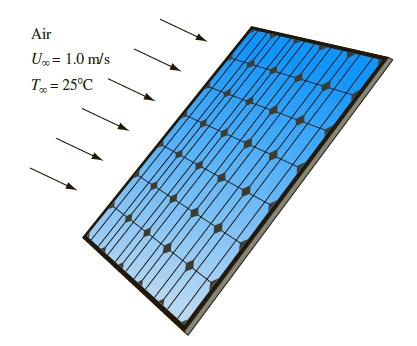To reduce the carbon footprint of building energy consumption, photovoltaic (PV) cell panels are increasingly being used
Question:
To reduce the carbon footprint of building energy consumption, photovoltaic (PV) cell panels are increasingly being used to provide a solar, self- sustaining source of electricity in both homes and large buildings. However, the semiconductor material that converts the solar light energy to electricity does not function efficiently at elevated temperatures, and the performance of a hot PV cell degrades. Externally mounted panels often rely for their cooling on atmospheric air. One such PV panel that has a square face (1 m × 1 m), as
shown in the figure, is mounted on the side face of a building with air flowing over across it in parallel. If the maximum allowable temperature of the PV panel always has to be ≤ 70°C, calculate the rate of convection heat loss from the face of the panel when air at 25°C flows over it with a velocity of 1.0 m/s. What is the heat loss if the wind speed decreased to 0.25 m/s? Also, do the results change significantly if the airstream is not parallel to the panel but has a pitch and yaw angle, relative to the panel alignment, or strikes it perpendicularly? Note that the heat loss, in many ways, gives the PV panel designers an estimate of the typical range of electricity generation and the PV cell operating efficiency.
Step by Step Answer:

Principles Of Heat Transfer
ISBN: 9781305387102
8th Edition
Authors: Frank Kreith, Raj M. Manglik, Mark S. Bohn





